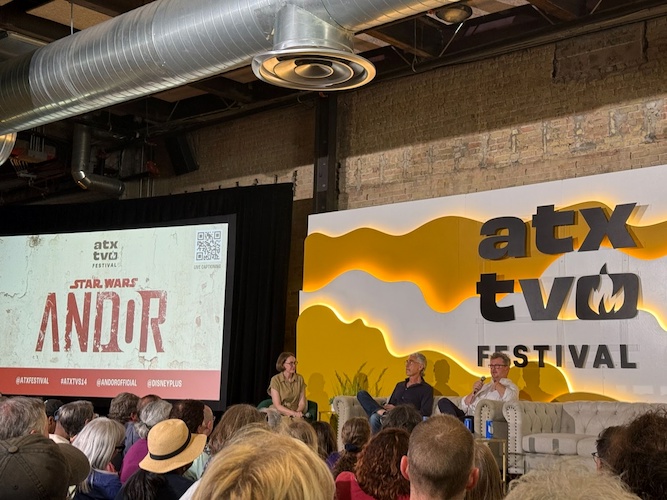"Andor" - How Disney’s Biggest Creative Gamble Led to the Boldest Star Wars Story Ever Told
When Disney greenlit Andor, they handed creator Tony Gilroy a staggering $650 million to tell the story of a doomed rebel spy across just 24 episodes—an extraordinary investment for a streaming series, especially one based on a supporting character from Rogue One: A Star Wars Story. But perhaps even more remarkable than the budget was the studio’s restraint. “I never took a note," Gilroy told the crowd at the 2025 ATX TV Festival, reflecting on the creative freedom he was given. “We said ‘[F***] the Empire’ in the first season. They said, ‘Can you please not do that?’" The line became “Fight the Empire," and other than that, the studio had no notes.
That level of trust allowed Gilroy and writer Beau Willimon to push Star Wars into uncharted territory, both narratively and tonally. As Willimon put it, Andor was “Star Wars for adults"—a series that honored the galaxy far, far away while refusing to be bound by its conventions.
Gilroy, who had co-written Rogue One, came into Andor with a clear understanding of what Star Wars could get away with—and what more he wanted to try. The second season in particular was built to defy hand-holding, following his “allergy to exposition" approach. “I wrote the beginning and the end of every script before handing it over," he said. “I’m trying to suggest the whole piece of the iceberg below the water. You should be able to feel it."
That restraint extended to performances. “I become really obsessed with my relationship—the script and the show—and just work’s relationship with the audience," he explained. “You want to make it so that it’s audience-proof. That it can be watched in a number of ways."
But Gilroy didn’t just want to provoke thought—he wanted to subvert expectations. After hearing the “slow burn" critique of Season 1, he leaned into the idea with Season 2’s opening. “I want everyone to think this is going to be really tedious… and then—bam—we’re going to steal a ship."
With no test screenings, no focus groups, and a production code-named Pilgrim to shield its secrets, Andor could fully commit to its mature tone. Willimon praised Gilroy for building a writing environment that welcomed big swings, including more adult humor and morally ambiguous character dynamics. “Tony did so well… he channeled a new kind of humor. He honored the humor of Star Wars, but in this super dark and adult way."
That included quietly including queer characters without turning it into a franchise-first headline. But when one of those characters—Cinta Kaz, played by Varada Sethu—was killed in Season 2, Gilroy was prepared for the reaction. “This is a show where we all know where it ends. Everyone’s going to die… our mentality was that almost everyone’s going to die, and that’s broadcast everywhere in the show."
He added that Cinta’s death by friendly fire was one of the earliest ideas for the season. “I would like to have friendly fire. I would like to have the stupidity of accident in the show," he said. Willimon called it a “magic trick"—a way to shock audiences while underscoring the cost of rebellion.
One of the season’s most haunting moments—Mon Mothma’s Senate speech—was part of Gilroy’s plan from the beginning. The use of the word “genocide" wasn’t intended as a political flashpoint, but its reception spoke volumes. “It’s really sad how many people can find a place to put this that’s meaningful for them," he said. Willimon noted that while the show reflects painful truths, it also aims to inspire. “Hope is a hard-won thing. You don’t wake up in the morning with a bucket full of hope."
Gilroy was clear that working on Andor made him a better writer. “I became so much of a better writer on this show because of the opportunity and because of the instruments that I had to conduct for and compose for and write to." He specifically credited Kyle Soller’s performance as Syril Karn for unlocking new depths in the material.
The panel closed with a series of audience questions, where Gilroy shared that the droid B2EMO was named after his son’s dog, a corgi named Bemo. “I wanted a droid that was a dog," he said. “I couldn’t adore him more."
He also revealed how much thought went into Diego Luna’s accent. “There are things that Diego cannot say," Gilroy admitted. He created the Kenari backstory to explain Cassian’s speech pattern and laughed, recalling Luna’s childhood confusion that R2-D2 was called “Arturito" (“Little Arthur") in the Spanish version of Star Wars.
Andor may be over, but its impact continues to ripple outward through fans, writers, and anyone who found something uncomfortably true in its depiction of fear, sacrifice, and resistance. As Gilroy said, “The choice you made from the very beginning was: I’m willing to sacrifice myself. Whatever that takes."
Stay tuned for more coverage from ATX TV Festival 2025!


